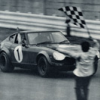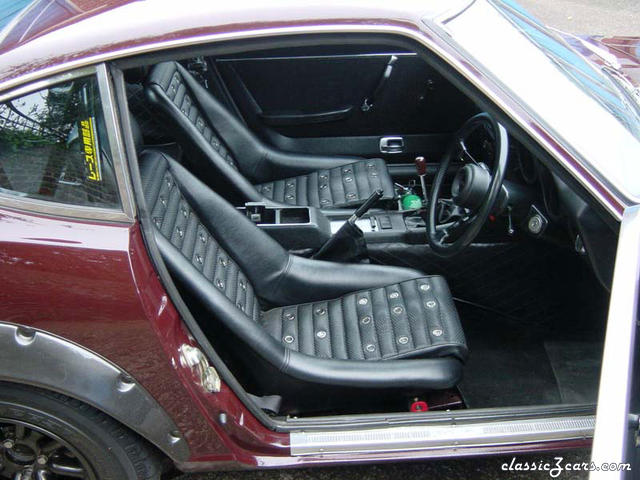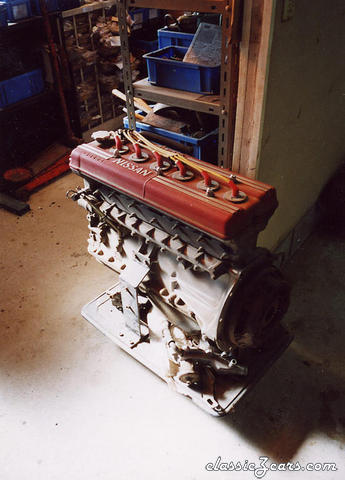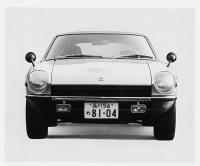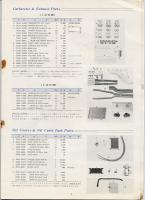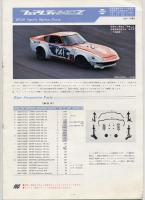Everything posted by HS30-H
-
Identifying Manual Transmission Type
Amen to that Mr C. Mike, you have almost certainly got a "B" type 5-speed donor rather than the ( shall we say, less common in the USA ) "A" type 5-speed. To make sure, have a look at the sticks and the bellhousings; the "A" type has a straight stick and removeable bellhousing. The "B" type has a "bent" stick and the one-piece bellhousing-primary gearhousing casting. You're doing things slightly differently to the normal scenario here. Usually its the case that people with earlier cars are asking if the later tranny will fit. On the shells that originally came with "A" type 4-speeds ( and cars with "A" type 5-speeds which were not officially imported to the USA market ) the issue is with the positioning of the shift lever in relation to the surrounding sheetmetal. Usually a little cutting is required. However, your 280Z will have originally come with a "B" type transmission - so there should be no fitment issues there. In fact, the transmission that you are putting into the car is probably younger than the car itself. Make sure that you use the correct throwout arm, bearing and collar. The best way to do this is to keep the clutch unit and all the throwout bearing pieces together as a unit, and not mix and match. Good luck, Alan T.
-
Early 2+2's
I don't know what that badge / emblem on the '74 Tokyo show car was, but I suspect it might have been something to do with the Fuel Injection spec. of the engine. Nissan were ( understandably ) quite proud of this, and the car on the stand at the show was probably the 'highest' spec. version ( and hence the most expensive ) Z available up to that point. In this case, it might have actually been fitted with the Auto trans too - so there's a possibility that the emblem was a type of Nissan Matic badge that never made it into production, as Mike suggested. The G-Nose was dropped after '73 - so that never made it through to production either. Therefore the car at the show was something of a concept car, and would not have had a special production code or 'new' type VIN prefix. There was no such thing as a "ZGRS-30" VIN - so we better be careful that Mike's dream car doesn't get written into the history books as something that was ever officially produced! As far as I am aware, that car was never shown outside Japan and does not exist any longer. The Japanese-market 2/2 badges ( they always call this model the "2 by 2" in Japan, rather than the "2 plus 2" ) were - as Alfadog suggested - placed on the front ( mesh ) grille. I've also seen them on the rear spoilers of Japanese-market cars, but as the rear spoiler was an Option part, these would have been put on by the owner or the dealer. This explains the different mounting positions of rear spoiler emblems that you sometimes see on Japanese-market cars. There were a few Japanese-market 2/2 models privately imported to the UK in the mid Seventies - so somebody here must have thought that they were worth having too. If they were bought at a bargain price in Japan ( and in many cases brought back from Japan - transported for free - by US servicemen ) it would have seemed a good deal I would have thought. I've recently seen a picture of a prototype / pre-prod 2/2 undergoing road testing in Japan. The photo was taken in 1971. We know that the 2/2 was designed alongside the 2-seaters in the late Sixties, but held back while sales and production concentrated on the 2-seaters ( see previous posts on the 2+2 threads ). Seems that they were evaluating and testing some cars way before they actually started full production. Years not months. So Mike, do you think your car is a proper "Export" model or a Japanese-market model? Maybe I haven't been following the thread properly, as I'm still confused! Alan T.
-
what is this???
I think Steve's estimate of roughly 700 cars over a two month period could well be quite a good ballpark figure - BUT, only for ( RHD ) HS30 prefixed VINS, which would include Japanese-market models that became available from late '71. After that period, production of HS30 models started to really ramp up. As far as its possible to tell, HS30 models never got into the sausage-factory mode of production that the HLS30 models did. The markets for the HS30 models were a lot greener than the USA market, and suffered from a fairly slow retail take-up in comparison to the LHD models ( a fairly complicated combination of factors was at work - including high retail cost due to Import taxation, a bad economic outlook, and possibly some brand prejudice too ). The Factory had its work cut out producing enough cars for the USA / North American market too, so the right-hookers tended to get put through the lines in a rather hap-hazard fashion linked to demand and convenience. I think we can imagine what it must have been like. I'm becoming more and more wary of quoting ANY production figures for these cars, and I think the figures for the RHD models are particularly dodgy. Lots of people seem to think they have some kind of handle on them, but I reckon they are quoting figures that have been guesstimated or plain made up. Nissan themselves have always been some of the worst culprits for mis-information in this department. I think I have about six different sets of year-on-year and model-by-model prod. figures from different Nissan-published or Nissan-provided sources, and I think ALL of them are inaccurate. To be honest, its probably only the USA / North American market cars that can have fairly reliable production figures / dates quoted for them. The cars that arrived in the USA / North American market were fairly well documented from the beginning, and had a proper branch of Nissan controlling the Import operation. Contrast this with other markets, where franchises and licensed importers were the norm, and its not surprising that the situation for the RHD cars is quite different. Add to this the oft-muted but hard to pin down rumours in Japanese enthusiast circles that RHD production figures were fudged and tweaked slightly, and you start to get more inkling that all is not as it might seem to be. Local and national clubs sometimes seem to have a fairly good handle on what, when and how many cars were sold into their market from new - but these are not always gospel either. I'm always puzzled by the American auto industry tradition of giving cars 'model' years. I think this confuses the issue when talking about Z cars in particular. I used to own a few American cars, so I'm familiar with the system and its logic. But as far as I am concerned, the only thing that matters when dating a car is the month and year it was made. If I could get the day and the time as well I'd be even happier! Anything else is just a local perception that came about because salesmen want to sell cars, and making them sound more modern or younger is to their advantage. That quote from Keith above is a good example: "My 71 has a production date of 11/70". I understand how this way of thinking came about, and that it isn't going to stop - but I DO think it can lead to some confusion when dating and pinning down the spec. on certain cars. Reading that kind of statement from outside the USA, it can appear quite illogical. I don't trust the production dates stamped onto the car's tags either ( I know that figures were tweaked slightly at the Factory to make some cars appear younger than they really were ) and in fact the Japanese-market and the UK-market cars had no official manufacturing date marked on them at all. Many of the Japanese Z specialists and enthusiasts that I have contact with are much more phlegmatic about the actual production dates of their cars. They don't like to try to attempt to be too accurate about the actual month of production, but tend to allow a combination of certain dating features and the VIN number speak for themselves. If this still leaves the actual month of production unclear, then so be it. I know it might sound rather un-Japanese - but they seem to accept that pinning down the absolute truth about RHD production dates and quantities is a fairly hopeless task. Quotes of RHD production figures can be wildly inaccurate. Try www.cybersanford.net for an amusing stab at these ( hello Bob - if you're tuning in, and no offence intended - as I'm sure that you got them from somewhere in good faith, and got that "An American car - made in Japan" quote thrown in for free ). I own a Japanese-market Fairlady S30 ( VIN number "S30-03761" ) which was sold in Tokyo in mid-1970 ( I have the original bill of sale ). According to the figures quoted on the cybersanford homepage, my car is very rare indeed! All in all, I just don't think its possible to be as accurate with the RHD figures as it is with the LHD figures. At some point we have to accept that fact and just do the best job we can based on the evidence that can be put together. I thought I was starting to get a handle on all this over the last few years, but its been dawning on me recently that if the Japanese enthusiasts and specialists think I'm on a hiding to nothing, then there must be something in what they say................ All part of the attraction and mystery of these cars, I think. I'm sitting here writing this as a kind of personal antidote to the wall-to-wall war coverage. My hobby is a refuge that I do not want the troubles of the world to invade. Peace and love everyone, Alan T.
-
Shall I install a 4.11 diff??
Steady on George, that might be taking it a bit too far......... I'm sure that the people at Haynes knew very well what they were doing - but you might need to keep in mind that some workshop manuals can tend to offer information on a "need to know" basis. ie - if they think you don't really need to know, then they might not put it in the manual.......... I can assure you that all of the UK-market cars came with the 5-speed ( and the Auto option was a VERY rare choice ), and the first of these had the "A" type. Your car ( which we think is a '73 don't we? ) would have had the "B" type 5-speed. I'm not sure if your car got an even later transmission along with its L28 engine transplant ( the gear ratios on UK-market 280ZX models were different from those in the earlier "B" boxes ) - so only a bit of research will uncover that. Rest assured that you would indeed not have noticed much useful improvement with the 4.1 ratio diff in comparison with the 3.9 ratio. All the best, Alan T.
-
What are you paying for gas?
Lachlan, There's a very good chance that you will be better at maths than I am ( I'm an old git now, you know............. ). I was trying to give a figure in US Gallons ( not Imperial Gallons ) - so that it would be easier to understand for the majority. Is that right - 3.79 Litres = 1 US Gallon? I know that 4.546 Litres = 1 Imperial Gallon..................... If you want to work it out for yourself and check up on my maths, I usually pay around 97-98p per Litre of 98 Ron "Super Unleaded" ( that's £0.97 to £0.98 ) here in the central London area. The £STG to $US exchange rate is roughly $1.60 = £1 at the moment. It's so expensive that I don't even want to think about it too much. Alan T.
-
What are you paying for gas?
The price I'm paying for 98 ron here in central London works out at roughly $3.75 ( USD ) per Gallon ( US Gallon, that is ). As Fred said, over here in Europe we know that a very large proportion of that is Excise Duty. Modern Governments use the motorist as a cash cow, and very little of the revenue that they raise from motoring-related taxation goes back into the road system or its upkeep. Its all being used to prop up other areas of the fiscal budget. The Government ( on a local and national level ) cannot actually afford the reality of a decrease in the use of the automobile, despite their propaganda telling us that we should all be getting on public transport. If we all did that the country would fall apart. Alan T.
-
Fairlady 240ZG ( HS30-H )
There is no shift pattern or emblem at all on the "Rally" shift knob. The Rally Clock was standard equipment on all Fairlady Z-L's and Z432's from 1969, and also on all Fairlady 240Z's ( including the ZG ) from late 1971. It was an extra money Option part on all other models during the same period. I don't know much about the Calendar Clock - but I think its from a later model ( RS30 / RLS30 or S31 series? ).
-
Shall I install a 4.11 diff??
George, Your particular car would have come from the Factory with the FS5C71B ( sometimes nicknamed the "bent stick" ) transmission. The "A" type ( "straight stick" ) was standard on the earlier UK-market HS30 models - but not on yours. Is your Mum's car an S12 or an S13 Silvia? Be careful, as the diffs are not always a straight swap for the R180 that I presume is still in your car. And if the diff currently in your car is the 3.9 ratio ( as it should be for a UK-market car ) then you will really not notice a huge difference if you fit a 4.1................ Alan T.
-
Wiring coming from Oil Sump...
George, That's the Oil Temperature sender you found. Your engine is from a 280ZX right? The 240Z that its installed in ( your car ) would not have a stock place to hook it up to - so that's why its not connected to anything............... Unless you want an Oil Temp gauge in your car, then I'd ignore it if I were you. Its one less thing to worry about. Regarding the bolts on your TCA's - the Factory usually installed them with the nut on the forward end, meaning you can withdraw the bolts towards the bellhousing rather than towards the steering rack. If yours were installed the other way around, then it was either built on a Friday afternoon at the Factory or somebody else has had them out before you. As has been recommended, they are best installed from the rearward side of the crossmember. Alan T.
-
Fairlady 240ZG ( HS30-H )
The Rally gear knob was offered as a Sports Option part by Nissan. My car has an Option 1 transmission, so shift pattern on the original gear knob would not have been accurate - as the Option 1 shift pattern is the "Dogleg" pattern.
-
S20 Twin Cam engine
PS30 ( Z432 ) VIN numbers went up over 500, but its generally accepted that less than 500 were made ( including PS30-SB's ). Judging by the data I have, and the data I have been given by 432 owners in Japan, it seems that somewhere around 470 may have been ( officially ) made - but its all a little grey. The Factory, and most books / mags covering the subject, usually quote around the 420 mark - but its clear that this is not accurate. They were made right from late 1969 through to 1973 ( although the '73 year cars were probably built in '72 ) and the main bulk were made and sold in 1970 & 1971.
-
jeco rally clock
-
Rally clock features
Ben, I think that's a later and more sophisticated version of the standard JECO electric clock than the Rally / Rallye / Stopwatch / Stop Clock, and you are right - it doesn't use the Oscillator unit. They are two different things. The Calendar clock is still a nice piece though. Alan T.
-
1973 KPGC110 "Ken&Mary" Skyline for sale $4500
If that car really IS a KPGC110 ( ie - a GT-R ) then somebody ought to buy it and sell it back to Japan. Real 110 Gt-R's are commanding higher prices than the C10 series two and four door GT-R's recently. Does anybody know the VIN number? If it did indeed start life as a GT-R and had a later engine change, then $4,500 is going to be well worth it. The whole thing hinges on the VIN though. If its 'just' a GT ( KGC110 ) then its not going to be worth enough in Japan and would not be worth repatriating. Its that magic "P" in the VIN prefix that would make the difference - despite the wrong engine and other missing parts. Even if its not a "P", surely somebody will buy it? It would not need that much to make it streetable / raceable by the looks of it. Come on somebody, dare to be different! Alan T.
-
Rally clock features
Hi Victor, I'm afraid its going to be a case of looking around for a good used unit privately, as they certainly aren't available new any more. Lots of people are looking for good working Oscillator units, as they are pretty much unrepairable once they give up the ghost. In the case of Spirit Garage, I would think you might well be barking up the wrong tree. They are less of an original-spec resto than a street and track performance tuning shop. There are so many private buyers chasing the Oscillators to replace broken ones, and so many people looking for a complete Rally Clock and Oscillator unit to upgrade their cars with, that I'm afraid its something of a seller's market. What with the onset of internet auctions, it kind of cuts out the resto shops and specialists. If the private buyers are willing to pay top dollar it really makes things rather awkward for the dealers and specialists who need to turn a profit. If I hear about one for sale I'll tip you off. You might be in a slightly better position than most in that you are only looking for the Oscillator and not the whole thing. All the best, Alan T.
-
Rally clock features
The clock with the Calendar is not the Rally ( "Stopwatch" ) Clock. That's a later option part. The proper Rally Clock is just as Victor describes it, and was fitted in certain Japanese-market models ( the higher cost versions ) as standard equipment from late '69, and as an option on the lower priced models. A few of them seem to have been specified on the odd Export model here and there, but the person who placed the order would have had to have known the option existed before they could order it. Is was not generally listed in anything other than the official Factory parts lists. The control box thingy is the Oscillator unit, which drives the head unit. Without the Oscillator the clock will not function. The Oscillator makes a nice warm humming noise when all is well, but tends to run the battery down pretty quickly if you don't use the car much.......... Just in case you are interested, the Rally Clock ( sometimes called the "Stopwatch Clock" or "Stop Clock" in Japan ) had the part number 27385-E4100, and the Oscillator part no. was 27395-E4100. Alan T.
-
electric fuel pump on 240z 260z?
Ben, Your European-market car will not necessarily have been built to the same specification as the USA / Canadaian-market cars - so the information that you get from references such as the Victoria British catalogue can sometimes be a little misleading. If your car was fitted with an electric fuel pump from the Factory, then it will usually be sited next to the Differential - on a bracket that is attached to one of the Transverse Link Mounting Brackets. Take a look under the rear of the car and you ought to be able to see it. However, as your car seems to have been fitted with the Turbo kit at the Janspeed factory, there is a good chance that an aftermarket electric pump was fitted elsewhere on the car. If it was fitted with just the normal mechanical pump I would expect it to suffer from fuel starvation and vapour lock in high temperatures. That turbine in the engine bay will surely make it very hot under there. It might be a good idea to get an aftermarket pump and fit it anyway. Your hard fuel lines - all the way from the rear to the front of the car - are also probably clogged with a mixture of rust and general sludge. I cut off the hard line on my project car and found it absolutely clogged with stuff. Nothing would have shifted that. If your car has been standing for a few years you might need to take a deep breath and remove the fuel tank for a proper flush and reseal. You can check the hard line out too, and replace it completely if in any doubt. Better than suffering endless fuel supply problems in the future............. So you went ahead and bought the car, eh? I think you will have a lot of work to do to bring it back to roadworthy condition.I still think its worth contacting JANSPEED to ask them some questions and get their recommendations. Good luck, Alan T.
-
did the 240Z have factory option triples?
Hi Ben, Copies of copies of copies are not to be sniffed at! Lots of my stuff is just copied, anyway. I figure that copies are better than nothing at all - that's for sure. Its amazing how many people don't know or even seem to care that the Sport Option lists existed.............. That's good advice you gave about the FIA homologation papers, and they are another thing I'd like people to recognise a bit more. I used to hang out with the old-Porsche world many years ago, and with the old Italian car community here in the UK too ( I had a few Lancias and Alfas, for my sins ) and it seemed that anybody who was interested in the sport and competition side of things knew all about the FIA homologated parts and the stuff that the Factory race teams used to use. I have to say that it does not seem the same in the Z world. Only a select few know or care about it all. Very odd, that. I've never seen one of the Formula Pacific lists, though. What's it got in it? Was that the formula that used the LZ18 / LZ20 engines? My friend Mr Matsui in Japan used to engineer Kazuyoshi Hoshino's car in F. Pacific. I visited him a couple of years ago and the car is still in his workshop. I can't for the life of me remember who made the chassis for it ( I think it was English though - maybe a Brabham or a Ralt. Whoops, that kind of makes it Australian in a way doesn't it!? ). That "Group G" list sounds interesting. Would like to see that. I think I know the article about the ex-pat Australian living in Japan with the "432-R". I think I remember that the article was not very accurate, and that the car was in fact NOT a true PS30-SB, and just ( "just" is relative in this case! ) a 'normal' 432 with a few tuning bits on it and not very Japanesque. I think the owner might have been guilty of a little exaggeration to an uninformed journalist......... All the best, Alan T.
-
what is this???
Hi Steve, Yes - 35 really did need a donor shell's help. There are certain rules and regulations here about keeping the identity of a car when it is being put into another shell ( they work it on a scoring system based on certain components having more relevance than others ). I wonder if you have a similar system over there? I think my description of the mounting positions for the Factory Spot Lamps was probably crap, and that's why you don't understand it. Sorry. What I mean is that they mount under the bumper, just on the inside of the two Over-riders ( when fitted ) as opposed to "outside" them ( which would be on the Indicator / Side Lamp side ). A picture saves a thousand words, so I've dug out this one to illustrate the correct positioning. The car illustrated does not have the Over-riders - but you can see the plastic grommets for their mounting holes and I think you can imagine where they would be. It makes the Fog Lamps pretty close to them I think. All the best, Alan T.
-
did the 240Z have factory option triples?
Here's a page from the '73 Sports Option catalogue which shows the carbs, manifolds and linkages etc. for the L-series engine type. Alan T.
-
did the 240Z have factory option triples?
The S20-engined cars were fitted with triple twin-choke MIKUNI N40PHH-A24 from the factory. The 44's were in the Sports Option catalogues for those cars, should owners have wanted to upgrade. The L-series engined cars, as Ben rightly says, never had the triple twin-chokes as "standard" equipment - but Japanese owners could get anything from the Sports Option lists fitted to their car should they so desire, and would usually go to one of the SPORT CORNER dealerships for this. These were the Nissan dealers with the better expertise on the tuning and modifying front, and they also sold the sportier models rather than the bread and butter models. Outside Japan, only the USA really got anything near to what the Japanese market had access to. From the days of the Roadsters, the US operation had tried to start supporting owners who wanted to go racing with the cars, and Datsun Competition really grew out of this. The Datsun Competition lists did not carry as many of the specialised parts for the Z car as the Japanese Sports Option lists, and sometimes they carried parts that were locally-developed and suited to the local market's specialist needs. Both the Japanese and the USA markets DID get the option of triple twin-choke carbs - but they were never fitted as "standard" equipment on any of the L-series engined Z cars. Best place to look for any documentation is either in the Datsun Competition parts lists, or the Japanese 'Sports Option' parts lists. Alan T.
-
Assembly tag
Victor, Was my effort not appreciated - or did you not notice it? Alan T.
-
Early 2+2's
Hi Mike, So 'your' car was made in late very '73 / early '74 then? Now you just have to figure out where it was from the time that it rolled off the line to the time it got re-rego'd in '76 - right? Have I got that straight? Its a little confusing. If it was a '73-build it would have to have been in the last days of late December, I reckon. And its definitely an Export model GRS30 isn't it? Not a 2-litre Japanese-market model with an L26 installed later on in its life? That Tokyo Motor Show car was a famous clanger dropped by Nissan; right up until the release of the RS30 and RLS30 models ( including the GRS30 and GRLS30 "2by2" / "2+2" models ) the Factory had been toying with the idea of making the Grande nose standard equipment. They showed the 2by2 with the G-nose at the Tokyo Motor Show and then backed down on it. Lots of people now report it as just a publicity exercise ( it even made the cover of Road and Track magazine ) - but its true that they really were considering making it standard. As we now know, they dropped the ZG model when the RS30 and RLS30 came out. All the best, Alan T.
-
Assembly tag
Hi Victor, You've found one of the Inspection Tickets for a component on your car. On S30-series Z cars, these were usually left attached to the complete dash assemblies, but found their way around the car and rested wherever they fancied once the string broke.......... The big writing on the outside says ( and forgive my romanised Japanese ) "Go Kaku Hyo" - roughly meaning 'Inspected', or "Passed". One the other side are a series of sections leaving spaces for information to be filled in either in handwriting or with a "Hanko" stamp: The top line is for the date, starting with the reign of the incumbent Emperor ( in this case Emperor "Showa" - who we knew as Hirohito ) and then the month and day. Just as a side-bar to this, the reign of Emperor Showa started in 1925 - so the date mark will signify the year of the reign. To get the year date that we use in the Gregorian calendar just add 25. On the right of that date section is a section for "Lot" or "Quantity". In the middle, on the left, is a space for the description of the vehicle model type, and to the right of that in two boxes, the part number and part description. Finally on the bottom left is a further box for description of the part function or other notes, and on the bottom right a place for the "Inspector" to mark his name or stamp his "Hanko" to sign it off. For completeness sake, the very small print at the bottom of the ticket identifies the printing company that made it ( in this case "Daiwa Press Ltd. Co." ) and the Form No. - followed by the date ( for this ticket, the 5th month of "Showa" 46 - so May 1971. See? Just add 25............. ). I can't see that its been filled in at all ( unless the writing has faded ) so somebody wasn't doing their job!................. These types of Inspection tags were usually attached to components and sub-assemblies that were supplied or put together by contractors, and then signed off by Nissan inspectors. If you dig around on old Japanese cars there are lots of things that can act as clues in identifying just when and where the components were made. I think its good fun to add all the evidence up and see the way that supply was being handled back at the Factory in the early Seventies, don't you? Hope that helped. All the best, Alan T.
-
what is this???
Hi Steve, Yes - 35 is really bad. Its actually being restored with the help of a donor shell from the correct period, if you know what I mean. The Fog Lamps had clear lenses as far as I remember ( its so long since I clapped eyes on a set...... ) and they mounted in the pre-drilled holes UNDER the standard front bumper, quite close to the Over-riders ( do you call them that in Australia? ) but on the "inside" of them - if you know what I mean. From what I've heard from friends in Japan, they were not all that powerful or effective............. All the best, Alan T.




